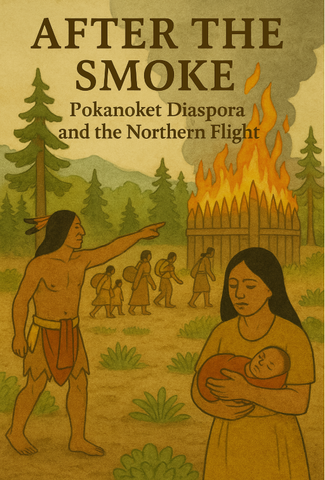
The Wetu: Traditional Home of the Northeastern Algonquian Peoples
The wetu (also spelled weetyoo, from the Massachusett or Wôpanâak language), sometimes known by the broader term wigwam, was the traditional dome-shaped dwelling used by many Indigenous peoples of the Northeast, including the Pokanoket, Narragansett, Massachusett, and Nipmuc.
The Wetu: Traditional Home of the Northeastern Algonquian Peoples
The wetu (also spelled weetyoo, from the Massachusett or Wôpanâak language), sometimes known by the broader term wigwam, was the traditional dome-shaped dwelling used by many Indigenous peoples of the Northeast, including the Pokanoket, Narragansett, Massachusett, and Nipmuc. These structures were crafted with bent saplings, typically young maple or ash, lashed into a frame and covered with bark, cattail mats (ponask), or woven reed panels. Designed with exceptional environmental adaptability, the wetu integrated seamlessly into the semi-permanent settlement patterns of Northeastern Indigenous communities, supporting their cyclical movements between winter inland encampments and coastal summer villages.
Design, Function, and Cultural Logic
The word wetu derives from the Algonquian root -wetu meaning "house" or "dwelling." Its dome-shaped frame was not only aerodynamic and insulated against the harsh Northeastern winters but also symbolic of the cyclical nature of life. The round form conserved heat in winter and allowed air to circulate in warmer months. Larger wetuash (plural) could house multiple families of up to 30 individuals, often arranged around central hearths with smoke vents at the apex for ventilation. Each had a multifunctional role as dwelling, workshop, birthing space, ceremonial site, and communal kitchen.(1)
Seasonal resettlement was a defining feature of Indigenous lifeways in the region. During the warmer months, coastal wetuash allowed for fishing, shellfishing, and planting near cleared fields. In colder months, families moved inland to more protected winter sites. These movements were intentional, sustainable, and embedded in a broader ethic of reciprocity with the land. Roger Williams, a 17th-century English settler and linguist observed, “Their houses are generally very small, being made with small poles and matts... they remove but a few miles, where they set up these houses again.”(2)
Construction and Gendered Labor

The construction of a wetu was a community endeavor rooted in gendered expertise. Men cut and bent the saplings, shaping the flexible skeleton of the home, while women wove and layered the bark and cattail mats, insulating the structure. This labor division reflects broader Algonquian social organization, where land use, food production, and architecture were shared responsibilities aligned with gendered domains.(3)
Living Architecture and Worldview
The wetu was more than a house, it was living architecture. Its circular design and use of natural materials reflected the Algonquian worldview, which saw humans as interconnected with their world, being part of a broader web of relationships rather than separate from this natural order. As Lisa Brooks argues in Our Beloved Kin, these homes were “inscribed in a landscape of stories, subsistence, and survival,” situated within an Indigenous sense of place that colonial maps and narratives often erased.(4)
Moreover, the portable nature of the wetu defied the European settler assumption that permanence meant legitimacy. Mobility was not aimless wandering but rather a deeply rooted practice of seasonal stewardship. As anthropologist Kathleen Bragdon explains, the flexibility of Algonquian dwellings “demonstrated an ecological sensitivity and a resistance to the static, grid-like settlement schemes imposed by colonial systems.”(5)
Sustainability and Environmental Stewardship
The wetu offers more than a historical window into Indigenous life, it provides a model for sustainable living in the modern world. Constructed entirely from local, renewable materials such as saplings, bark, and cattail mats, the wetu exemplifies a low impact, regenerative approach to architecture. Its design required no nails, synthetic insulation, or deforestation. When a structure was no longer needed, its materials were returned to the earth, biodegrading without harm.
In an era of climate crisis and ecological degradation, the wetu invites us to reconsider dominant models of housing and land use. Its seasonal mobility reflected a deep respect for the carrying capacity of the land and the importance of regeneration. Rather than extracting from a place indefinitely, families moved in rhythm with natural cycles, allowing ecosystems time to recover. As Indigenous scholar Melissa K. Nelson notes, such practices reflect a "sacred ecology" in which human habitation is woven into, rather than imposed upon, the natural world.(6)
Reviving and learning from Indigenous technologies like the wetu challenges the assumption that sustainability is a modern invention. These homes were inherently sustainable, not as an afterthought, but as a core principle. They remind us that ecological intelligence is embedded in cultural memory, and that the future of environmental stewardship may very well be in our willingness to learn from the past.
References
William Simmons, Spirit of the New England Tribes: Indian History and Folklore, 1620–1984 (Hanover: University Press of New England, 1986), 45–47.
Roger Williams, A Key into the Language of America (London: Gregory Dexter, 1643), 28.
Kathleen J. Bragdon, Native People of Southern New England, 1500–1650 (Norman: University of Oklahoma Press, 1996), 110–14.
Lisa Brooks, Our Beloved Kin: A New History of King Philip’s War (New Haven: Yale University Press, 2018), 6–7.
Kathleen J. Bragdon, The Columbia Guide to American Indians of the Northeast (New York: Columbia University Press, 2001), 92.
Melissa K. Nelson, “Original Instructions: Indigenous Teachings for a Sustainable Future,” in Original Instructions, ed. Melissa K. Nelson (Rochester, VT: Bear & Company, 2008), 9–17.












